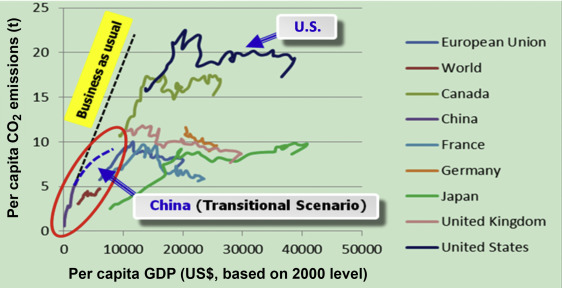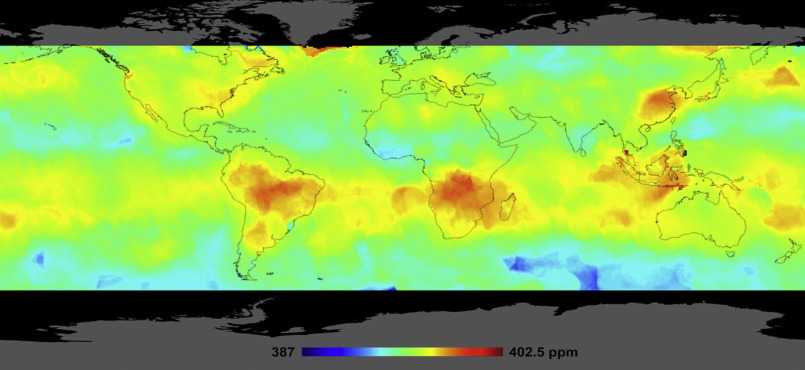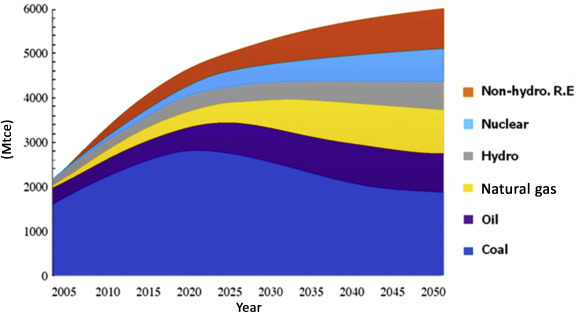Abstract
This study discusses high-carbon characteristics, the unsustainability of Chinas development, and the fact that China needs to transform its development mode. Chinas low-carbon transition must include industry structure adjustment, energy saving and efficiency increases, energy structure improvement, carbon sink development, adaptation capability, and low-carbon pilot schemes.
Low-carbon urbanization is a key measure in Chinas low-carbon transition. Chinas urbanization faces high-carbon risks. Thus, this study presents a roadmap for transforming urbanization into a low-carbon one. The transition to low-carbon urbanization is a common trend in the developing world. There is a lot of room for international cooperation.
Keywords
Low-carbon transition ; Urbanization ; Risk ; Roadmap
1. High-carbon characteristics and low-carbon transition of Chinas development
After years of rapid economic development, China has increasingly realized the unsustainability of growth based on an excessive consumption of resources and environmental degradation. Chinas energy consumption per unit GDP is nearly double the world average. In 2013, China made up 12.3% of the worlds total GDP, yet consumed 21.5% of global energy.
Annual CO2 emissions in China have already reached 7 t per capita and continue to increase, approaching EUs and Japans levels (Fig. 1 ). Some of Chinas more developed eastern regions have annual per capita emissions greater than 10 t, more than the historic peak levels of the EU and Japan (see Fig. 2 ).
|
|
|
Fig. 1. Energy-economic analysis (Notice the red circle) (WB, 2015 ). |
|
|
|
Fig. 2. Global satellite-derived PM2.5 concentration averaged over 2001–2006 (unit: μg m-3 , van Donkelaar et al., 2010 ). |
In China, the use of coal and oil accounts for >60% of PM2.5 , and the use of fossil fuel accounts for ∼80% of GHG emissions of the country. Data show that eastern regions' coal consumption spatial density is 12 times the world average and the CO2 emission spatial density is six times the world average (Fig. 3 ).
|
|
|
Fig. 3. Average CO2 concentration in October–November 2014 (NASA, 2014 ). |
The most fundamental means to realize sustainable development, improve air quality, and address climate change is by avoiding resource-intensive high-carbon developments and embarking on a journey toward ecological civilization through green and low-carbon development. Therefore, China has established national strategic goals for low-carbon development in the INDC, submitted to the UN in June 2015.
It is necessary for China to transform its current development mode. Chinas low-carbon transition may include the following details:
- Industry structure adjustment. Six industries accounted for 64.5% of the total energy consumption during 2012.
- Energy saving and efficiency increase. China has contributed 50% to the worlds energy saving over the past 20 years.
- Energy structure improvement. Fossil fuels will not be exhausted anytime soon; thus, the efficient and clean use of fossil energy is of significant practical value. Efforts should be made to increase the proportion of natural gas (including unconventional gas) used in primary energy. Non-fossil fuels such as renewable and nuclear energy are the mainstay of future energy. According to the CAE report (RGCAE, 2011 ), in China, non-fossil energy will account for 15% of the primary energy structure in 2020, and reach >20% in 2030, and 40%–45% in 2050 (Fig. 4 ). The proportion of non-fossil energy will eventually exceed that of fossil energy, and this will be a historical landmark for an energy revolution in China. The electricity utilization pattern should be based on “network + energy,” which includes distributed energy, smart grids, and high-capacity storage (physical and chemical).
|
|
|
Fig. 4. Chinas primary energy structure (RGCAE, 2011 ). |
- To develop carbon sink, adaptation capability, and low-carbon pilots.
2. Low-carbon urbanization is a key measure for Chinas low-carbon transition
2.1. High-carbon risks of urbanization
From the present year to 2030, Chinas urbanization rate can increase by 15%–20%, eventually reaching 65%–70%. Whether urbanization can maintain a low-carbon development course remains a severe challenge entailing high-carbon risks, specifically for the following:
- A substantial increase in building areas during urbanization and reconstruction of existing urban infrastructures will lead to considerable energy consumption from building (including energy consumption from construction material manufacturing and construction activities). This accounted for 41% of the gross energy consumption in China in 2012, with the construction industry consuming 915 Mt of steel, 3.73 Gt of cement, 64 Mt of aluminum, and 4.48 weight boxes of glass. With the urbanization rate increasing by 1%, new building areas will annually increase by 800 million m2 and hence reach 16 billion m2 by 2030, becoming a critical source of carbon emissions.
- During urbanization, energy consumption by residents will significantly increase; moreover, because of agricultural modernization, energy consumption by hundreds of millions of peasants residing in rural areas will increase. According to the World Energy Council, Chinas household electricity consumption averaged at 1349 kW h in 2010, with the global average reaching 3471 kW h; this level was exceeded by all developed countries. However, if Chinas energy structure undergoes no significant improvement, the domination of coal power will certainly lead to an increase in coal consumption and carbon emissions as the living standards of residents improve.
- If cities continue to expand in a rough manner, the coefficient of urban land-use growth elasticity (ratio of urban land-use growth rate to urban population growth rate) will continue to rapidly increase (reaching 2.28 in China, with 1.12 being the internationally recognized reasonable limit). Unscientific urban planning will aggravate the separation of work from residence, thus leading to an increase in vehicle traffic and recurrent “tidal traffic.” Such passive transport needs give rise to long travel times and distances, which in turn lead to the emergence of hundreds of millions of new vehicles and the consequent substantial increase in fuel consumption and carbon emissions.
- If the development model cannot be effectively transformed, combined with the adverse effects of rough development, the abovementioned risks will be aggravated. Regarding the lifestyle guidance policy, if all provinces vie with each other for urbanization speed and rate instead of truly considering green and low-carbon approaches as hard indicators for new urbanization, i.e., if all provinces fail to advocate a low-carbon lifestyle but vie with each other for luxury, high-carbon emissions would occur, and the social morality, spirit, and culture would be jeopardized.
2.2. Roadmap of low-carbon urbanization
Its possible to avoid the high-carbon risks of Chinas urbanization and embark on a road to low-carbon development. To this end, we must make a massive effort and take the following measures:
- Identify the philosophy and guiding ideology for new urbanization and announce low-carbon as a key feature and a major criterion for evaluating urbanization.
- Scientific urbanization planning. We must develop specific planning and design for low-carbon urbanization to reflect the intensive and compact urbanization model, provide necessary functions, allow convenient public transport, avoid “separation of work from residence,” and reduce the energy consumption from transport. We should also avoid mass-demolition, mass-construction, the construction of poor quality short-life buildings, and define and monitor the standards for low-carbon buildings.
- Readjust the industrial structure. We must reduce the number of high energy consumption industries, boost the service and other emerging industries, control the total energy consumption, and achieve low-speed growth of the total energy consumption.
- Optimize the energy structure. We must significantly reduce direct coal burning (to be replaced by gas, electricity or industrial exhaust heat), curb the growth in motor gasoline fuel, develop mini-type electric motor vehicles, and reinforce the development of three low-carbon energy sources: natural gas (including non-conventional gas), renewable energy (water, wind, solar, biomass, terrestrial heat, and ocean energy), and nuclear power, thus increasing the proportion of low-carbon electricity in the power supply structure to 50% or more.
- Elaborate the design and implementation of the distributed low-carbon energy network. We shall allow “on-site and cyclic” provision of the energy needed during the course of urbanization. The decision regarding which energy source is to be used needs consideration of local realities, such as the availability of natural gas, solar energy, biomass energy, and terrestrial heat, and we shall also allow for the recycling of agricultural, forestry, and domestic wastes. Correspondingly, efforts shall be made to develop micro-grids and energy storage technologies.
- Develop the biological carbon sink in urban forests and protect grasslands and wetlands. Urbanization shall be accompanied by the construction of beautiful rural areas.
- Advocate a low-carbon lifestyle. We must construct low-carbon communities and villages, develop low-carbon product certification, logos and services, gradually improve the carbon trade and carbon market, and enable the broad participation of urban and rural areas.
- Vie with each other for low-carbon rates and urbanization quality instead of urbanization speed and urbanization rate.
- Draw on the experience of other countries regarding low-carbon urbanization.
3. Conclusions
Low-carbon transition and development is not merely for climate change mitigation, but more for sustainable development of the country and humankind. Chinas international responsibilities for addressing climate change and meeting the domestic demand for sustainable development are strikingly similar. Addressing climate change internationally and domestically can be promoted and supported to mutual advantage.
Urbanizations low-carbon transition is a common trend in the developing world. Many countries face similar problems with scientific, technical, and industrial development and embrace extensive opportunities for international cooperation.
References
- NASA, 2014 NASA (National Aeronautics and Space Administration, U.S.); NASAs Space Borne Carbon Counter Maps New Details; (2014) http://www.nasa.gov/jpl/oco2/nasas-spaceborne-carbon-counter-maps-new-details
- RGCAE, 2011 RGCAE (Research Group of Chinese Academy of Engineering); Research on the Energy Development Strategy of China in Mid and Long-term (2030, 2050); Science Press, Beijing (2011) (in Chinese)
- van Donkelaar et al., 2010 A. van Donkelaar, R.V. Martin, M. Brauer, et al.; Global estimates of ambient fine particulate matter concentrations from satellite-based aerosol optical depth: development and application; Environ. Health Perspect., 118 (6) (2010), pp. 847–855
- WB, 2015 WB (World Bank); World Development Indicators; (2015) http://data.worldbank.org.cn/indicator/all
Document information
Published on 15/05/17
Submitted on 15/05/17
Licence: Other
Share this document
Keywords
claim authorship
Are you one of the authors of this document?



